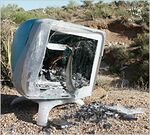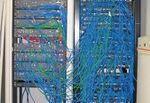HowTo:Build a computer

|
HowTo This article is part of Uncyclopedia's HowTo series. See more HowTos |
This is a guide on how to be able to build a computer. Bill Gates has threatened to sue Uncyclopedia over this article numerous times, and feels better every time. So continue to read at your own interest.
Introduction[edit]
As the modern age trundles along at its fast and technological pace, you may think it is time to update your lifestyle by getting yourself a nice, easy-to-use personal computer. It just so happens that a local corner shop up the street is giving out computers at an incredibly high and stupid price; something in the region of 100,000 to 1,000,000 pounds/dollars. You may think yourself able to buy such an expensive computer; after all, you might be incredibly rich and amazing. The truth is, however, that you should not even consider buying such an expensive computer. Such computers are for the stupidly rich who have nothing better to do with their money. You are definitely not one of those people, are you?
You need to get a good PC without emptying your coffers. You do not want an expensive model. Neither do you want a cheap PC; they will no doubt be of poor quality. So what can you do? Why, build your own! That's right, you can always build your own PC, free of charge, using your own time and resources. No, of course there isn't any legislation stopping you from building a PC. Such jargon is made up by the main computer industries just to scare people into buying their wares.
Making a PC is as simple as anything. All it takes is a few simple ingredients and a few simple instructions. This guide will tell you what those ingredients are, and outline said instructions to you.
Basic Ingredients[edit]
Picture somebody baking a cake; they add flour, milk, honey, and some other bits and pieces to make it just right. Building a computer is near enough the same process (minus the flour and milk, of course). To start building your PC, you need to collect a list of bits and bobs that are necessary for your computer to work.
Below is a compiled list of computer ingredients:
- Outer casing - This will be the mixing bowl of your computer, in which all of the pieces will be put. Any sort of box will do for the casing, be it cardboard, metal, or chest of drawers. Make sure it is durable and heat resistant; computers generate a lot of heat, and nobody likes a computer covered in melted bits of cardboard.
- Fan - This is used to cool down your computer when it gets hot. An office fan should do the trick.
- Monitor - This will show whatever your computer wants to show you. It is a necessary piece of equipment if you want to watch or see anything. A T.V will suffice as a monitor, providing you attach it correctly.
- Hard Drive - This is the storage box that your computer will put all of your work in. For this, you can use a memory stick or CD; anything that holds storage can be used as your hard drive.
- CPU - As the "Central Processing Unit", this is the main processor for all your trash. If you want to avoid buying this expensive garbage disposal, feel free to just attach a meat grinder, or a paper shredder onto your motherboard.
- Motherboard - This is probably one of the trickiest pieces to find. Your computer needs this to help it out with stuff and to be bossed around. You could try asking a mother to help you find this part. Should this fail, stick her into the computer as the part. Otherwise go out and buy one.
- Mouse - This lets you control whatever you see on the monitor. This is relatively hard to replicate, so try to attach a pen to some wires as a mouse. DO NOT use an actual mouse, as it will not like where you shove the wires. Plus, it can bite you unexpectedly.
- Keyboard - This is the thing you use to talk to your computer. Most computers do not have ears, so you have to use the keyboard to communicate with it. Anything that has keys or letters and numbers on it will do for a keyboard. This can range from an old typewriter to a 'My First Letter' toy set.
Mixing Method[edit]
Now that you have all of the ingredients, you will need to be able to put them all together into something that will resemble a computer. Simply pushing all of it into the box and hoping it will work will not do. Putting the computer together will require talent, glue, and a LOT of wires. Sometimes a hammer is required to ensure parts are fastened together properly.
It is possible you are not cut out for such work, and will no doubt hurt yourself by trying. You have two options from here:
Make sure to buy some wires. You/the nerd might need them.
- Get help. Nothing is better than getting some professional help. Ring up any professional 'nerds' from your school days and ask them to fix your computer. Most nerds will be happy to come over and partake in casual merriment with your computer. If they ask what the heck you did to your computer, make up an elaborate story involving an Ancient. You do not want to make yourself seem like a fool in front of a nerd by explaining how you were building a computer. Not only would they laugh in your face, they would insist on taking you to the expensive store and buying one for you, with your money!
- Give up. Just give up. Bill Gates wins. You lose. You admit to Noel Edmonds that you are not smarter than a 10-year-old, nor are you capable of building a computer by yourself. Game over.
If by lucky coincidence you chose the get help option, then a nerd should have arranged the bits of your computer into something more manageable. They probably used a lot of wires as well.
Basic Programming[edit]
If you used your actual mother as a motherboard, then you need to do some programming to give the computer some guidelines.
Press F5 (or F8) when your computer starts up. It'll start if you've got a motherboard with a chip in it, and a little bit of RAM. then type press the option to go to command prompt. type 'edit system.com' then make up some nerdy sounding words- like 'GOTO' with some numbers after them (this always works). do NOT delete your new system.com file, it is your new operating system. call it whatever you want (as long as the filename stays the same).
Software[edit]
Much like a sofa, a computer needs something soft in it to make it work. Taping bits of fabric to the computer will make it much softer, but thats not what I'm talking about. The software has to be special software, if you know how to sew, so much the better!! Take out your needle and thread, and find something soft (i.e. teddybear)- then sew it up with some more fluffy stuff and thread or something.. then stick it into the computer. Now you have an operating system, and software to run on it.
If you really get lazy (or don't know how to sew), go to a garbage can (or dumpster), and root around until you find Windows 98.. it's in there somewhere.. Or else go on the internet at your nerd friend's house, and download Windows from the internet.. Note: You do not need Windows, DOS works just fine.. but you'll need a 5 1/4 inch drive to install it, go back to the dumpster.
Conclusion[edit]
Hopefully, at the end of this guide, you should have pieced together a functional computer, with Windows (or DOS) on it! It may look rubbish and badly-constructed, but you can edit Uncyclopedia pages now! On your own computer! No more going to the school library and looking like a dork. at all!

